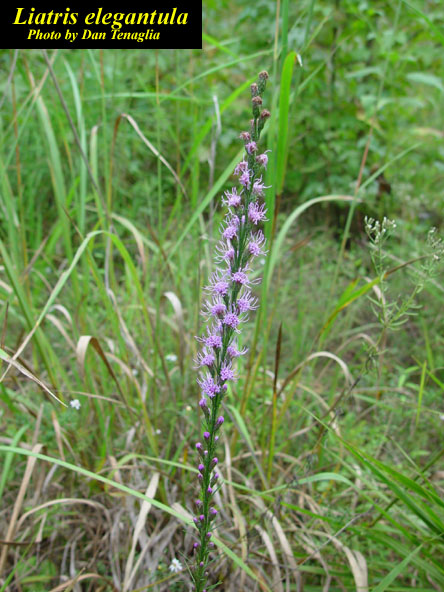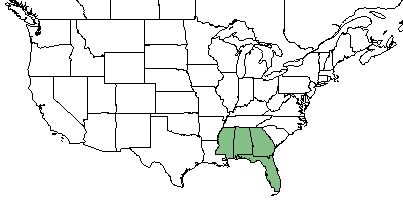Difference between revisions of "Liatris elegantula"
(→Ecology) |
Emmazeitler (talk | contribs) (→Taxonomic Notes) |
||
| Line 19: | Line 19: | ||
}} | }} | ||
==Taxonomic Notes== | ==Taxonomic Notes== | ||
| − | Synonyms: ''Liatris graminifolia'' Willdenow var. ''elegantula'' (Greene) Gaiser; ''Laciniaria elegantula'' Greene; ''Laciniaria graminifolia'' (Willdenow) Kuntze | + | Synonyms: ''Liatris graminifolia'' Willdenow var. ''elegantula'' (Greene) Gaiser; ''Laciniaria elegantula'' Greene; ''Laciniaria graminifolia'' (Willdenow) Kuntze.<ref name="weakley">Weakley, A.S. 2015. Flora of the southern and mid-atlantic states. Working Draft of 21 May 2015. University of North Carolina at Chapel Hill, Chapel Hill, North Carolina.</ref> |
| − | Varieties: | + | Varieties: none.<ref name="weakley">Weakley, A.S. 2015. Flora of the southern and mid-atlantic states. Working Draft of 21 May 2015. University of North Carolina at Chapel Hill, Chapel Hill, North Carolina.</ref> |
==Description== | ==Description== | ||
Revision as of 16:57, 22 September 2020
Common name: shaggy blazing star [1]
| Liatris elegantula | |
|---|---|

| |
| Photo by the Atlas of Florida Plants Database | |
| Scientific classification | |
| Kingdom: | Plantae |
| Division: | Magnoliophyta - Flowering plants |
| Class: | Magnoliopsida - Dicots |
| Order: | Asterales |
| Family: | Asteraceae |
| Genus: | Liatris |
| Species: | L. elegantula |
| Binomial name | |
| Liatris elegantula Greene | |

| |
| Natural range of Liatris elegantula from USDA NRCS Plants Database. | |
Contents
Taxonomic Notes
Synonyms: Liatris graminifolia Willdenow var. elegantula (Greene) Gaiser; Laciniaria elegantula Greene; Laciniaria graminifolia (Willdenow) Kuntze.[2]
Varieties: none.[2]
Description
L. elegantula is a perennial forb/herb of the Asteraceae family native to North America. [1]
Distribution
L. elegantula is found in Mississippi, Alabama, Georgia, and Florida. [1]
Ecology
Habitat
L. elegantula is found in sandhills and other dry woodlands. [3] Specimens have been collected from drying sand of open pine oak woodland, red clay soils, burned pineland, hardwood stand, peat of savanna, pine flatwoods, limestone glade, broom sedge old fields, longleaf pine wiregrass savanna, sandy old field, borders of hardwood hammock, and on bank of river.[4]
Conservation and Management
Cultivation and restoration
Photo Gallery
References and notes
- ↑ 1.0 1.1 1.2 USDA Plant Database https://plants.usda.gov/core/profile?symbol=LIEL7
- ↑ 2.0 2.1 Weakley, A.S. 2015. Flora of the southern and mid-atlantic states. Working Draft of 21 May 2015. University of North Carolina at Chapel Hill, Chapel Hill, North Carolina.
- ↑ Weakley, A. S. (2015). Flora of the Southern and Mid-Atlantic States. Chapel Hill, NC, University of North Carolina Herbarium.
- ↑ URL: http://herbarium.bio.fsu.edu. Last accessed: June 2018. Collectors: Loran C. Anderson, R.K. Godfrey, K.E. Blum, R. Laxor, A.F> Clewell, S.W. Leonard, Gary Knight, W.G. D'Arcy, Angus Gholson, Wilson Baker, Richard Mitchell, J.P. Gillespie, V. I. Sullivan, Ann Johnson, MacClendons, Geo. Wilder, Paul Redfearn. States and counties: Florida (Wakulla, Madison, Jackson, Leon, Jefferson, lafayette, Clahoun, Gadsden, Levy, Taylor, Dixie, Nassau)